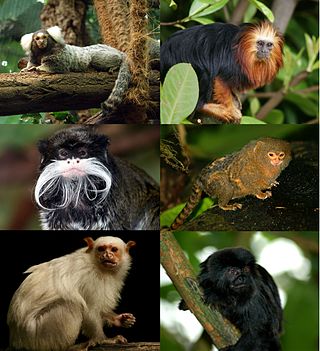
The Callitrichidae are a family of New World monkeys, including marmosets, tamarins, and lion tamarins. At times, this group of animals has been regarded as a subfamily, called the Callitrichinae, of the family Cebidae.

The marmosets, also known as zaris or sagoin, are twenty-two New World monkey species of the genera Callithrix, Cebuella, Callibella, and Mico. All four genera are part of the biological family Callitrichidae. The term "marmoset" is also used in reference to Goeldi's marmoset, Callimico goeldii, which is closely related.

The buffy-tufted marmoset, also known as the buffy tufted-ear marmoset or white-eared marmoset, is a New World monkey that lives in the forests on the Atlantic coast of southeast Brazil. Of all the marmosets, it has the southernmost range.
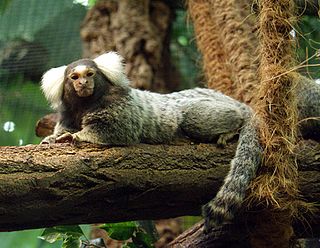
The common marmoset, also called white-tufted marmoset or white-tufted-ear marmoset, is a New World monkey. It originally lived on the northeastern coast of Brazil, in the states of Piauí, Paraíba, Ceará, Rio Grande do Norte, Pernambuco, Alagoas, and Bahia. Through release of captive individuals, it has expanded its range since the 1920s to Southeast Brazil, where it became an invasive species, raising concerns about genetic pollution of similar species, such as the buffy-tufted marmoset, and predation upon bird nestlings and eggs.

The Roosmalens' dwarf marmoset, also known as the black-crowned dwarf marmoset, is a small New World monkey native to the Amazon Rainforest, on the east bank of the lower Madeira River, and the west bank of the Aripuanã River, in Brazil. It has the smallest distribution of any primate in Amazonia. This marmoset has several unique attributes, which has resulted in it sometimes being placed in the monotypic genus Callibella. However, genetic analysis has subsequently resulted in its being classified within the genus Mico.

The Santarem marmoset, also known as the black and white tassel-ear marmoset, is a marmoset endemic to the Brazilian states of Amazonas and Pará.

The Emilia's marmoset, also known as Snethlage's marmoset, is a marmoset endemic to Brazil. It is found only in the Brazilian states of Pará and Mato Grosso. It was named to honour German-born Brazilian ornithologist Emilie Snethlage.

Prince Bernhard's titi monkey, also called the zog-zog monkey, is a species of titi monkey in the genus Plecturocebus, first described in 2002. It is named after Prince Bernhard of the Netherlands. They have varying coloration of gray, black, and agouti, with dark orange in certain regions. They are endemic to Brazil, found mostly in disturbed forest environments. While officially listed as least-concern by the International Union for the Conservation of Nature (IUCN), they may, in fact, be at-risk due to human-caused deforestation.
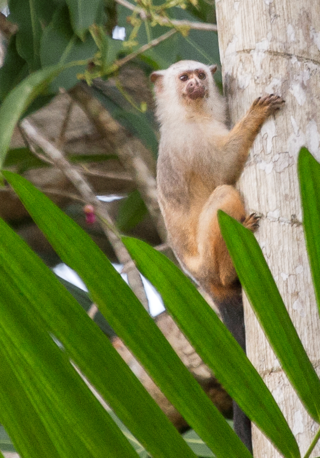
The Rio Acarí marmoset is a marmoset species endemic to Brazil. It was first described in 2000.

The gold-and-white marmoset, also known as the golden-white tassel-ear marmoset, is a species of marmoset, a small monkey endemic to the Amazon rainforest in eastern Amazonas state, Brazil.

The Marca's marmoset is a species of marmoset that is endemic to the Amazon, in the Aripuanã-Manicoré interfluvium in Brazil. Its body is light grey, with orange legs, a black tail, a pinkish face, and naked ears. It is about 9 inches (23 cm) long, excluding the tail, and it has a 15-inch (38 cm) long tail. It weighs about 12 ounces (340 g).
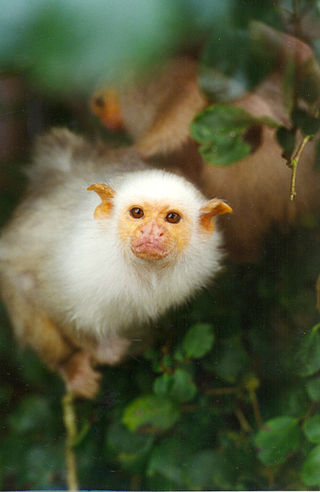
Mico is a genus of New World monkeys of the family Callitrichidae, the family containing marmosets and tamarins. The genus was formerly considered a subgenus of the genus Callithrix.

Callithrix is a genus of New World monkeys of the family Callitrichidae, the family containing marmosets and tamarins. The genus contains the Atlantic Forest marmosets. The name Callithrix is derived from the Greek words kallos, meaning beautiful, and thrix, meaning hair.
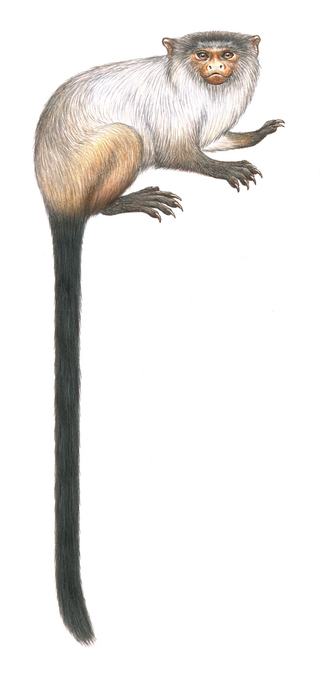
Rondon's marmoset, also known as the Rondônia marmoset, is a small species of monkey from the family Callitrichidae found in the south-western Amazon in Brazil. It is endemic to the state of Rondônia, and its range bordered by the Rio Mamoré, Rio Madeira, Rio Ji-Paraná, Serra dos Pacaás Novos and possibly Bolivia. It was only described in 2010, and its name refers to the famous Amazonian explorer Cândido Rondon. Prior to its description, it was included in Emilia's marmoset.

The Munduruku marmoset is a marmoset endemic to Brazil. It is found only in the southern Amazon, in an area of approximately 120,000 km2, from the right bank of the Jamanxim River, below the mouth of the Rio Novo, to the mouth of the Tapajós River, below the mouth of the Cururu River. According to researcher and discoverer Rodrigo Araújo, approximately half of the distribution area lies within Mundurucu Indigenous Territory in the Amazonas state. The name sagui-dos-Munduruku is a tribute to the Munduruku people who lives in the same location as the species.
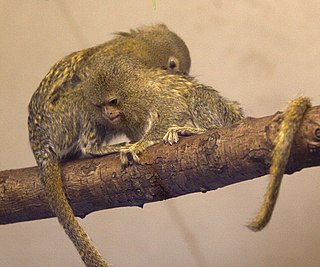
The eastern pygmy marmoset is a marmoset species, a very small New World monkey, found in the southwestern Amazon Rainforest in Bolivia, Brazil, Ecuador, and Peru. It was formerly regarded as conspecific with the similar western pygmy marmoset, but the eastern pygmy marmoset has whitish colored underparts. Although the eastern pygmy marmoset occurs further east than the western pygmy marmoset, the primary separators of their ranges are the Amazon River and Maranon River, with the western occurring to the north of them and the eastern to the south. The species has recently been confirmed by DNA testing to exist in Ecuador, hundreds of kilometers north of the Maranon River.
The Parecis titi monkey is a species of titi monkey, a type of New World monkey, endemic to Brazil.

















